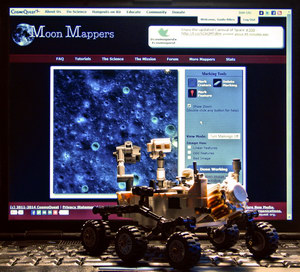 The Lego Curiosity Rover compells you – go map the Moon at CosmoQuest.org! Or you can go planet mapping on Mercury or asteroid mapping on Vesta!
The Lego Curiosity Rover compells you – go map the Moon at CosmoQuest.org! Or you can go planet mapping on Mercury or asteroid mapping on Vesta!
The mapping projects have always been a cornerstone of the citizen science projects of CosmoQuest, allowing everybody to contribute to science in an easy, instantly understandable way. Crowdsourcing the identification of craters and other unusual landmarks on the Moon, Mercury and Vesta is as easy as drawing a circle on the screen, but helps enormeously the scientific understanding of these surfaces. And the success is there – in March of this year, the Moon Mappers study was accepted in Icarus, a major peer-reviewed scientific journal, showing that crater identification by citizen scientists is practically as good as if experts were doing it. Two years after the beginning of CosmoQuest, the idea of creating a virtual research lab has now been scientifically proven to be extremely useful.
But what does this really mean for the participating non-scientist? In preparation for the coming Hangoutathon fundraiser, a new series of articles headlined Your Science Results Explained is is giving the answers to this question, because the original paper is admittedly not so easy to understand for non-scientists. But leave it to CosmoQuest to boil the publication down to a more easy level, because this is what they do best: making science accessible for everyone!
To get started with the Moon-, Mercury- or Vesta-Mapping, all you need is to register for free on CosmoQuest.org – this login also works for their Forum as well – and start circling craters on the Mappers websites. You will be shown an introductory video guide the first time you log in so you know what to do, but all in all it’s fairly easy and fascinating as well, because you get to explore the surfaces in great detail and often see images nobody has ever closely looked at before. The mappers websites not only work on the desktop PC, but also on tablets, although with some reservations – I had tested them on several different Android browsers recently and only Dolphin was able to render the Mappers flawlessy for some reason, so I can really recommend it for crater-mapping. Drawing the circles on the tablet is a bit tricky especially on small display sizes, but even on 7″ devices it works well especially if you can use a stylus.
There is also a free Android app called Moon Mappers Crater Decay from CosmoQuest which lets you grade crater images on their level of decay. And you can also buy their educational game Earth or Not Earth for $1.99 (or €1.49 if you’re in Europe) with the proceeds going to CosmoQuest to fund their programmers – the app is also available for iOS devices now. Even if you don’t want to play it, it’s a great way to make a micro-donation!
And regarding donations, of course you can always give something to CosmoQuest, but if you can’t, at least spread the word and support them by doing a little public outreach. And watch the Hangoutathon this weekend, it will be amazing! :-)